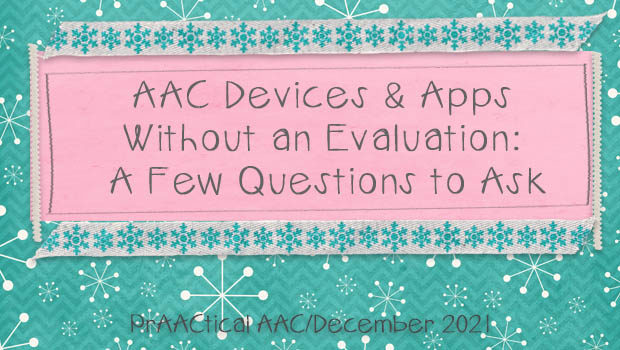AAC Devices & Apps Without an Evaluation: A Few Questions to Ask

In a perfect world, everyone who needs AAC would participate in a comprehensive assessment to guide the selection of what SGD and/or AAC app will best meet their needs. That evaluation would include a records review, interviews with key stakeholders, observation, direct assessment, and a period of trial use with the communication aids that seem to be the best fit. It’s a complex and time-consuming endeavor, but the feature match process has been the gold standard for AAC device/app selection for several decades.
At times, this process is skipped in favor of a quicker approach.
- Bhodie’s school team already supports several other students with AAC needs and most of them use a popular AAC app on an iPad. Since they are already familiar with that tool and it seems to be working well for other students, they tried it with Bhodie, too. He was successful in using it to request some favorite things, ask for ‘more,’ and indicate when he was finished playing during a consultation visit with the district’s AAC Specialist. Based on this experience and discussion with his teacher and SLP, they decided to provide him with one for the next few months. If he does well with it, they will continue using that device and app. If not, they’ll try something else.
- Aimee was a teenager before her parents learned about AAC from friends in an Angelman support group. They were excited by the successes that other families were reporting and eagerly purchased an AAC app that was suggested by several parents and a few professionals in the online support group. No time to waste, they felt. Let’s just get started.
- JT learned about AAC from other autistic adults and was eager to explore some options for those times when he found it too stressful, exhausting, or effortful to talk. After talking to his friends about their experiences and looking at the web pages of a few AAC tools that they recommended, he selected a few things – both no tech and high tech – that seemed appropriate. JT has been using them successfully ever since.
- Theo is on the waiting list for an AAC evaluation at a university-based clinic. His family was told that it would be at least 9 months before a spot opened up, so they decided to purchase an AAC app for him to use in the meantime.
There are many situations that lead to someone getting an AAC device and/or app in the absence of a full evaluation. When these individuals show up on our caseloads and in our classrooms, it often gives us pause. Should we start fresh with a comprehensive evaluation or just move forward with the intervention and instruction that will help them meet their communicative needs with their current set of AAC tools?
Here are a few things to consider when determining how to proceed.
- How are things going with the AAC device/app that the learner is currently using?
- Has AAC been integrated into daily experiences? Are supportive practices being used on a frequent basis (e.g., aided language input, extended pause time)?
- Is the learner progressing as expected?
- How do they seem to feel about their AAC tools?
- What is the team’s perception?
- Is AAC being implemented with fidelity?
- Does the team show any signs of resistance or device abandonment?
- How has potential AAC user’s rate of communication learning changed?
- What else has changed in the AAC learner? Do they seem happier or less stressed? Are they more actively engaged in learning activities and interaction? Are they showing signs of growth and independence?
- What is the opportunity cost of using the current set of AAC tools? What is the possibility that a different set of AAC tools would be more beneficial than the one that the person is currently using?
- Does the current tool provide the communicator with access to robust language?
- If not, what is the plan for facilitating language growth?
- Are there any unmet needs that could be better addressed by a different set of AAC tools?
- What are the implications of potentially changing to a different set of tools?
- From the learner’s perspective?
- From the family’s perspective?
- From the perspective of educators and therapists?
- Were any institutional guidelines, rules, or mandatory processes bypassed?
- What would be the next steps and timeline for a full evaluation, if the team were to move in that direction?
There are many things to consider when determining whether to backtrack and complete an AAC evaluation or move forward with the current set of tools. Are there other factors that you’ve found to be significant in making these decisions? We’d love to hear your ideas.
Filed under: Featured Posts, PrAACtical Thinking
This post was written by Carole Zangari
